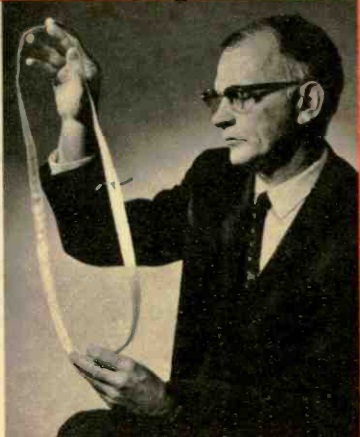
Mobius resistor. Wikiepdia image.
Shown here in the November 1969 issue of Electronics Illustrated is Richard L. Davis of Sandia Laboratories, the inventor of the Möbius resistor, US Patent 3267406A.
Many youngsters will be familiar with the Möbius strip. It’s a three-dimensional object with one side and one edge. It is formed by taking a strip of, for example, paper, making a twist, and then taping the ends together. To prove that it has one side, the young scientist can draw a line down the middle. Eventually, the line will connect up, but only after covering “both” sides of the strip, in effect proving that there is only one side. The strip can also be cut along that line, which will form another strip, this one non-Möbius.
Davis used the Möbius strip to form a resistor. His strip of paper was coated with foil. When it was attached together. The outside of the strip formed a continuous conductor, and connections were made directly opposite. The result was that current was flowing on the outside of the strip, but in opposite directions. Therefore, the magnetic fields cancelled out, making the resulting device non-inductive. This proved useful at UHF, since the stray reactance of a resistor would otherwise be very significant at those high frequencies.
Students looking for an interesting science fair project could make either a Möbius strip or a Möbius resistor. A student will almost certainly get a participation ribbon by making the strip and then unsuccessfully attempting to cut it in half. But more advanced students, armed with an inexpensive RCL meter, can get the blue ribbon by showing that the inductance disappears by adding the twist to the strip.

